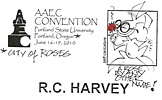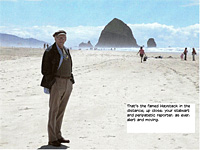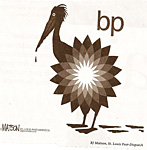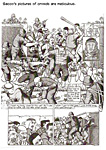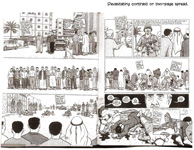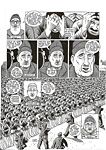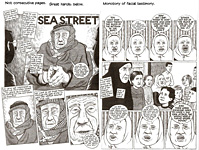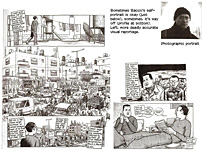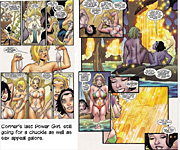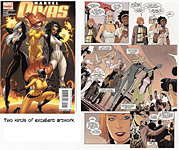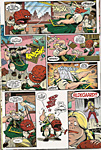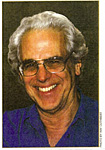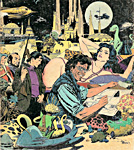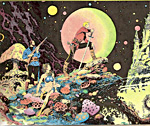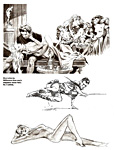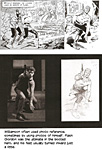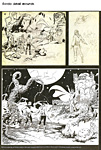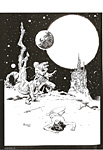 |
|||||||||||||||||||
Opus 264 (July 5, 2010). We remember Al Williamson at the end of this posting; midway through we review Joe Sacco=s daunting Footnotes in Gaza, and at the beginning, we report on the annual convention of the Association of American Editorial Cartoonists. And in a spasm of reviews, we inspect X-Men: Xenogenesis; Buzzard, Rawhide Kid: The Sensational Seven; DV8: Gods and Monsters; Diva, Fin Fang Four Return, Iron Man: Armor Wars; Tom Strong and the Robots of Doom; Dead Run; Kato, Green Hornet: Year One, Green Hornet; Avengers Prime; Darkstalkers, Devil, and Joe the Barbarian. Here=s what=s here, in order (so you can skip over whatever pontifications you aren=t interested in), by department: NOUS R US Comic-Con Goes Hollywood Some More 30th Anniversary of World War 3 Piraro Says Syndication Joins the Web Playboy Cartoon Count EDITOONERY AAEC Convention Report Newspapers Surviving the Economic Crunch Editoons of the Month 9 Chickweed Lane in the Ninth Month GRAPHIC NOVEL Joe Sacco=s Footnotes in Gaza
FUNNYBOOK FAN FARE Reviews of first issues: X-Men: Xenogenesis; Buzzard, Rawhide Kid: The Sensational Seven; DV8: Gods and Monsters; Diva, Fin Fang Four Return, Iron Man: Armor Wars; Tom Strong and the Robots of Doom; Dead Run; Kato, Green Hornet: Year One, Green Hornet; Avengers Prime; Darkstalkers, Devil, and Joe the Barbarian AL WILLIAMSON: 1931 - 2010 And our customary reminder: don=t forget to activate the ABathroom Button@ by clicking on the Aprint friendly version@ so you can print off a copy of just this installment for reading later, at your leisure while enthroned. Without further adieu, then, here we goC
NOUS R US The Comic-Con International Sandy Eggo continues to turn itself into a Hollywood marketing adjunct. All the success producers of comic book superhero movies have had at the Con in drumming up enthusiasm for their projects has inspired rafts of producers of other kinds of movies to hawk their wares at the nation=s premiere geekfest. Ditto tv series. Saith Entertainment Weekly: AUp to 40 broadcast and cable series that vary in scope from ABC=s comedy-drama >Castle= to CBS= >Hawaii Five-O >reboot and FX=s sitcom >It=s Always Sunny in Philadelphia= are hoping to attract new followers among the 125,000 people expected to converge on the city=s convention center July 22-25. >It=s an incredible promotion and marketing machine where you are able to speak directly to the most hardcore fans,= says 20th Century Fox tv chairman Dana Walden. ... >They become a buzz factory. They blog about the shows and build them into the fabric of their lives.=@ So now we=re no longer comic book geeks: we=re a buzz factory, a marketing machine. Sigh. I=m goin= this year again, so I hope to see you there. I don=t have a table or a booth of my own, but I=ll be dropping by the National Cartoonists Society=s booth from time to time; and maybe GoComics Uclick/Universal. WRITER NEIL GAIMAN has won the prestigious children's fiction prize, the Cilip Carnegie Medal, for his fantasy tale The Graveyard Book, a novel about an orphaned boy brought up by ghosts. The book also won the Newbery Medal. ... The AJonah Hex@ movie is apparently a flop; Entertainment Weekly reports that no one likes it and no one bought tickets for it. But AToy Story 3" won the box office honors two weekends in a row. So far (July 2.) United Media syndicate reports (in July=s Editor & Publisher) that Lincoln Peirce=s Big Nate comic strip, which had been merely Achugging along@ for years, has suddenly experienced a surge in client newspapers: drawn in a simple kid-like manner, it looks to newspaper editors like another version of Jeff Kenney=s improbably popular Diary of a Wimpy Kid, and the increase in newspaper sales has yielded yet another benefitCa series of Big Nate books. The week of June 28, Jim Toomey began in his Sherman=s Lagoon a two-week series that takes his finny cast to the Gulf of Mexico on a mission to save the sea dwellers affected by the BP oil spill. Reports Alan Gardner at DailyCartoonist.com, who has previewed the sequence: AJim does a good job keeping the humor true to the strip and avoids becoming preachy. This is not the first time Jim has used his strip to build awareness of environmental issues. Jim has been twice honored by the National Oceanic and Atmospheric Administration for his efforts to raise awareness of ocean conservation and marine life protection.@ ***** THE 30TH ANNIVERSARY of World War 3, the nation=s longest-running political comic, was celebrated in May. Peter Kuper and Seth Tobocman, founders of the magazine, and a handful of artists from the collective it has grown into, convened for a weekend of performance, music, art and workshops, reported Kathryn Geurin at Metroland. Kuper and cofounder Tobocman grew up together in Cleveland, Awhere the young artists immersed themselves in reading comics and creating fanzines.@ She quotes Kuper: AAnd by young I mean, like 11. And 12C and 13 and 14,@ he chuckles. Geurin continues: AThe pair found themselves at art school in New York City at the dawn of the =80s andCin the days before the vast soapbox of the InternetClacking a forum for the work they wanted to create, work that used the comic form to challenge the political climate of the Regan-era Cold War and Iran-Contra scandals.@ Kuper recalled: AWe had the impetus, the subject matter and the desire to do comics, so it came together. We bought the paper in one place and had it printed in another place. We hand-assembled all of them and walked around and sold them. We sold them in street, in the hallway outside the cafeteria at school. I think it cost us about 700 bucks. AWe were seeing work that we thought was important, but we weren=t seeing it in newspapers,@ Kuper went on. AIt would be pasted on a lamppost or sprayed on a wall, and it would disappear at first rain or be painted over in a matter of days. Part of what we wanted was to capture this history in a magazine. We saw these things going on. And they weren=t just going to disappear in the first rain.@ There would be documentation, he said, that Awe didn=t all just stand by.@ Today, Kuper is known for his mainstream work, regular contributions to Time, Newsweek and The New York Times, a shelf=s worth of graphic novels, and ASpy vs. Spy,@ his monthly comic in Mad magazine. But WW3, for which contributors have never been paid, continues to be a labor of love, passion and free expression for its founders. ***** DAN PIRARO, winner of this year=s Cartoonist of the Year Reuben trophy, didn=t attend the Memorial Day weekend convention of the National Cartoonists Society where the award was conferred. Although he was one of the three publicly acclaimed finalists, he was missing the whole weekend. King Features chief Brendan Burford accepted the award for Piraro, saying the cartoonist was at a fund-raiser for animal rights in upstate New York. Rumors, howeverC according to our Vast Network of SpyCclaimed Piraro was ignoring the festivities because NCS had so often ignored him: he=d been nominated for the Reuben eight times before without winning, so he supposed this would be the ninth such humiliation. We never believe rumors, but we report =em anyhow. In the current (July) issue of Editor & Publisher, Piraro is interviewed and says it=s Aa great honor@ to get the Reuben. ATo be honest,@ he says, AI didn=t think that a relatively >outsider= panel like Bizarro would ever be considered for a hall-of-fame-type award, so I=m surprised as well as flattered.@ Bizarro passed its 25th anniversary last January. It began, Rob Tornoe notes in his interview with Piraro, Aas a replacement for The Far Side when Gary Larson left Chronicle Features and moved to Universal.@ He was seeking wider distribution Awhile his popularity lasted,@ Piraro said. When he talked to Larson at about that time, Piraro added, Larson Aseemed convinced that The Far Side could be a flash in the pan. Bizarro basically followed the sales path of The Far Side; big cities picked it up first and small markets followed much, much later.@ (One of Larson=s first venues was the Seattle Times, for which, in 1979, he started drawing Nature=s Way for the Sunday edition. That summer, he went to San Francisco where the San Francisco Chronicle=s syndicate arm picked up the feature and re-titled it The Far Side, starting in the paper on January 1, 1980; later, it was distributed nationally, and when Larson=s contract expired in 1984, he moved to Universal.) In answer to the persistent question of where he gets his ideas, Piraro once quipped that when Bizarro was accepted for syndication, he immediately thought up twenty-five years= worth of ideas and he=s been using them ever since. But once the panel passed its quarter-century mark six months ago, he=s been busy thinking up new ideas. AI surf the Web first thing in the morning, catch up on my favorite cartoons and blogs, the news, various pop culture sites, etc.,@ he explained to Tornoe. AEventually, something pops into my head and I gnaw on it until it amuses me and turns into a cartoon. Beyond that, I can=t say [where, or how, the ideas come from]. I never write jokes while actually living life, don=t carry a notebook or anything like that. It really only happens when I sit down to write.@ He said doing the daily panel takes him 20-30 minutes from blank paper to finished art; Sundays, which are somewhat more spacious, might take as much as 90 minutes but usually just an hour. AThe coloring, which is done on the computer, adds about as much time again. Coloring them is actually my favorite part of the process these days.@
SYNDICATION THRASHINGS AND FLAILINGS The same issue of E&P (July) is the journal=s annual directory of syndicates and syndicated features, and it is accompanied by an article purporting to survey the fate of syndication in the present newspaper climate of financial desperation. From the syndicate perspective, the situation is conflicted: financial cutbacks at newspapers have resulted in loss of staff, leaving newspapers eager for such content as syndicates can provide; but Athe same budget woes that left editors short-staffed and in need of material also left them with less money for new syndicated products.@ Judging from the article, syndicates are reacting by devising ways to help newspapers ramp up their websites, which seems to me counter-productive. The websites are still offering mostly free services, so how can they pay for syndicated material? Reporter Debra Gersh Hernandez interviewed a couple of Internet-oriented syndicates that I hadn=t yet heard ofCFamily Features and Content That WorksCand United Media and Creators but not Universal or King, two of the industry=s biggest. Both of them, however, are also exploring digital futures allied with newspapers= doing the same. No one, alas, seems interested in developing the greatest undeveloped newspaper market in the countryCnamely, the small town (100,000 population or less) daily and weekly newspaper, all of which are financially healthier than their big city brethren.
PLAYBOY COUNT-DOWN We haven=t done a cartoon tally of one of the last bastions of magazine cartooning recently, so here it is. The 126-page July Playboy has only 4 full-page cartoons and 8 small cartoons in the back of the book, plus the Olivia pin-up =toon and three Astrips@ (Meaty Myths, Dirty Duck, and the Juan Alvarez/Jorge G. full-pager). The ratio of cartoons to page count (not counting Olivia) is: full-pagers, 1/31.5; small, 1/16; over-all, 1/10.5 (that is, 1 cartoon every 10-and-a-half pages). But that=s just the Afirst time@ cartoons; John Dempsey gets 8 reprints spread over two pages, another of the Playboy Aclassic reprise@ cost-cutting efforts (which puts cartoons in the magazine but doesn=t have to pay first printing prices). In the 1990s, the ratios of full-pagers and small cartoons to page count were 1/22 and 1/18-20; in the 1960s and 1970s, about the same. But the magazine had many more pages, so the number of cartoons was much greaterCfull-pagers in the teens; small cartoons in the thirties. The May 2010 issue (130 pages) was virtually the same as the July issue all overCsame number of cartoons and strips, same ratios. The cartoonists whose work appears in full-page color most often are Gahan Wilson, Kiraz, and Doug Sneyd. Dean Yeagle and Frank Thorne show up every so often, too, but that first trio is present almost without fail. In the back pages lately, we see pin-up cartoons of Playboy bunnies by Don Lewis. My guess is that these are left-overs from a one-time Playboy Club publication, VIP I think it was called, where Lewis= cotton-tails appeared regularly. Another cost-cutting maneuver is my surmise: probably these have been lying around in inventory since the demise of VIP, and they=ve probably been paid for, so why not use =em? Fascinating Footnit. Much of the news retailed in the foregoing segment is culled from articles eventually indexed at rpi.edu/~bulloj/comxbib.html, the Comics Research Bibliography, maintained by Michael Rhode and John Bullough, which covers comic books, comic strips, animation, caricature, cartoons, bandes dessinees and related topics. It also provides links to numerous other sites that delve deeply into cartooning topics. Three other sites laden with cartooning news and lore are Mark Evanier=s povonline.com, Alan Gardner=s DailyCartoonist.com, and Tom Spurgeon=s comicsreporter.com. And then there=s Mike Rhode=s ComicsDC blog, comicsdc.blogspot.com and Michael Cavna at voices.washingtonpost.com./comic-riffs . For delving into the history of our beloved medium, you can=t go wrong by visiting Allan Holtz=s strippersguide.blogspot.com, where Allan regularly posts rare findings from his forays into the vast reaches of newspaper microfilm files hither and yon.
EDITOONERY The 54th annual meeting of the Association of American Editorial Cartoonists (AAEC)
convened June 16-19 in Oregon=s Portland, a municipal collection of
diverse neighborhoods, assorted forests, thickly sprouting flora and steep
hills separated by gulliesCa locale originally known as AThe Clearing@ but eventually named at the
conclusion of an argument settled by the toss of a coin. Two early residents,
Francis Pettygrove from Portland, Maine, and Asa Lovejoy from Boston, vied with
each other to impart to the vicinity the name of their erstwhile hometowns;
Pettygrove won the toss, and the Oregon Historical Society purports to have the
now famed APortland Penny@ on display in its headquarters. AAEC=s attendance at 87 this year was somewhat less than last year=s 109 at nearby Seattle (107 the year before in San Antonio); of the 87, 48 were actual cartoonists (including 5 cartoonists from Iraq, Palestine, and Egypt), the rest being spouses, syndicate representatives and guest panelists. Among the inky-fingered fraternity, only 23 of the 48 work full-time as editorial cartoonists, and only 15 of those on the staffs of newspapers. The remaining part-time editooners are staff artists who occasionally produce editorial cartoons or freelancers who have other kinds of day jobs. The non-staff full-timers include (by way of example) Daryl Cagle (who runs an online syndicate while also cartooning), Jeff Danziger (syndicated without a home newspaper), Matt Wuerker (whose work appears in the online newspaper Politico), and this year=s Pullet Surprise winner (as Garrison Keillor so deftly puts it), Mark Fiore (who self-syndicates his animated editoons). AAEC membership has declined somewhat in the last yearCfrom 350 to 320Cdue to an administrative purging of some so-called members who were several years behind in paying dues. Membership breaks into regular members (226), associate members (32 persons involved in tangential endeavors), students (20), retired (32), and Ahonorary@ (10). While the number of members seems reasonably healthy, it includes roughly 120 who haven=t paid dues lately, some (maybe a couple dozen) still carried on the rolls despite owing for four or more years. Steps are underway to resolve this oddity. The organization is back in the black financially, having slowly regained solvency after a disastrous spending spree at its 50th anniversary meeting four years ago. The number of full-time staff editoonists remains at about 80, which is where it stood a year ago, down 20% from the May 2008 total of 101. In other words, the newspaper industry is apparently finished purging itself of what it regards as superfluous staff. Some enthusiastic doom-sayers peg the number of full-time staff editorial cartoonists as low as 58, but they are wrong. Or they are counting in idiosyncratic ways. Mike Keefe talked about an online cartoon country he and Tim Menees have devised at sardonika.com; patterned after the Iota comic strip the two did years ago, the site attempts to Amake sense of nonsense and vice versa@ with faux newsstories and satirical cartoon characters in positions of political power (the imaginary country=s president is named Ruttles). Here=s a look at vintage Iota.
Ted Rall talked about his successful fund-raising efforts in support of his forthcoming return trip to Afghanistan; one wag on the panel joked that people donated money in the hopes that Rall wouldn=t make it back. Matt Bors moderated a panel of local Portland cartooners who are forging careers in various ways, some alternative press, others in four-color comicsCShannon Wheeler, Meredith Gran, and Jeff Parker. Mark Fiore explained the brouhaha with Steve Jobs over the cartoonist=s submission of an app for iPhone that was first rejected because it Adefamed public personages@ and was then accepted once Jobs and his crew realized, as Jobs put it, that political cartoonists got caught in a too glibly devised rule that produced unintended consequences (see Opus 263). It made sense at some initial stage in the Apple store=s development that apps not Adefame@ anyone; apparently no one thought about editoonists, and once they did, the rule no longer made quite as much sense. Fiore pointed out that Aridiculing@ a public figure is not the same as Adefaming@ that individual, and apparently Jobs agrees. Fiore pronounced himself satisfied that the incident had Aopened the door@ at AppleCthat the publicity surrounding the rejection of a Pulitzer-winning cartoonist had resulted in Jobs= dropping the ban on ridiculing public figures, which is, after all, what editooners routinely do as a profession. There transpired a brief period during the hullabaloo over the past month or so when it appeared that Jobs had called Fiore a liar. But that turned out to be entirely untrue. After several days of hot transmissions of varying degrees of Aevidence,@ it finally emerged that, no, Jobs had not called Fiore a liar after all. Jobs was talking about numerous Aother people@ when he said they were liars. But not Fiore. Fiore, Jobs said, was Aa nice enough fellow.@ (And to prove it, Fiore showed a clip of the tv interview of Jobs during which he made this pronouncement.) Cartoonists from the Middle East talked, through interpreters, about the hazards of political cartooning in Egypt, Iraq, and the West Bank, where a high level of illiteracy makes pictorial commentary more potent than in literate environs. Frank Swoboda, who heads the Herb Block Foundation, delivered himself of aggressive, almost belligerent, remarks that he hoped would prod editoonists into doing something about their rapidly evaporating profession. Like many big city newspapermen (which is what he was before his Foundation appointment), Swoboda thinks that newspapers are within a few minutes of expiring altogether. I chimed in, indulging my penchant for perversity by saying that while I agreed that the industry isn=t as robust as it was 20 years ago, it=s pretty far from being endangered: small town newspapers (serving populations of 100,000 or less) are still healthy financiallyCand that=s most of the newspapers in the country. Swoboda pounced in response, saying, not quite on point, out that many of those papers typically don=t carry comics. That=s true, but that only identifies an undeveloped market for syndication, and my point was that by moaning about the terrible fix of big city newspapers, we misdirect our attentionCfocusing on eschatology rather than opportunities, which, because we are so exercised over the fate of 100 big city papers, we fail to see. (For more in this vein, see *Good News? below.) At AThe American Masters@ session, Jeff Danziger responded to questions by The Oregonian=s Jack Ohman, co-chair, with Bors, of the meeting. Perhaps the most intriguing of the sessions was a presentation by Tjeerd Royaards and Caroline Dijckmeester, who introduced the assembled multitudes to an innovative online presence, vjmovement.com, which promises to be a source of income for otherwise penniless out-of-work editoonists. Based in their native Netherlands, the Avisual journalism movement@ is an international operation involving over 150 video-journalists and political cartoonists that is growing day-by-day. Believing, as they put it, Athat there is more than one truth,@ the vjmovement wants to support Athe diversity of perspectives,@ creating a truly global news and commentary network of editorial cartoonists. AEditorial cartoons can poke, harass, jab, outrage, infuriate, tickle and enlighten,@ the presenters noted, adding that cartoons Aattack arrogance and ignorance, corruption and abuse, expose those who need exposing, defend freedom and can even bring about change.@ Cartoonists who want to participate submit cartoons, and the vjmovement Anewsroom@ selects which ones to publish, after which, the cartoonists are paid (as much as $75 per cartoon, as I understand it). Published cartoons are then available for purchase by interested journalistic enterprises, which is how vjmovement generates the income from which contributing cartoonists are paid. And now, merely for the fun of it, here are my sketches of various personages that stood up in front of the spit-ball flinging crowd and got immortalized for their audacity.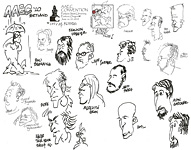 At
a recognition dinner during the AAEC festivities, the Cartoonists Rights
Network International (CRNI) conferred upon Iranian cartoonist Mana Neyestani
the 2010 Courage in Editorial Cartooning Award. Neyestani was jailed in 2006
for drawing an illustration on the children=s
page of a government newspaper showing a cockroach responding to a question
with the word, "Namana,@ a Turkish Azeri slang phrase meaning,
"I don't get it." Although the intention was wholly innocuous,
Iranian Azeris thought the government was continuing the centuries-long
hostility toward them by classing them with cockroaches, and riots ensued,
resulting in five deaths. Neyestani was jailed for two months. Subsequently, he
fled the country, and with the help of CRNI, he got as far as Malaysia with his
wife. He is currently working on a graphic depiction of those two months in an
Iranian jail. At
a recognition dinner during the AAEC festivities, the Cartoonists Rights
Network International (CRNI) conferred upon Iranian cartoonist Mana Neyestani
the 2010 Courage in Editorial Cartooning Award. Neyestani was jailed in 2006
for drawing an illustration on the children=s
page of a government newspaper showing a cockroach responding to a question
with the word, "Namana,@ a Turkish Azeri slang phrase meaning,
"I don't get it." Although the intention was wholly innocuous,
Iranian Azeris thought the government was continuing the centuries-long
hostility toward them by classing them with cockroaches, and riots ensued,
resulting in five deaths. Neyestani was jailed for two months. Subsequently, he
fled the country, and with the help of CRNI, he got as far as Malaysia with his
wife. He is currently working on a graphic depiction of those two months in an
Iranian jail. 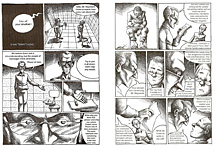
AAEC=S CONVENTION LEAVES AFTERNOONS OPEN, and I gathered up the loose-ends at which I found myself by visiting the Portland Art Museum which had just opened an exhibition of original art from R. Crumb=s Book of Genesis and by touring the Dark Horse headquarters in nearby Milwaukie. Crumb=s drawings, page after page of them, are astonishing for their pristine state: no white-out, no corrections. And no visible Aunderdrawing@Cthat is, pencil sketches that guide to the final inking. The lettering in speech balloons was perfect in nearly all instances: I found only one speech balloon in which white-out had been applied. The blemish-free state of the drawings can easily be explained by assuming Crumb used a light table, tracing pencil roughs in ink on the final artboard. But I doubt that he did it that way. By squinting closely at the drawings, I could make out the barest traces of non-photo-blue-penciling, which, I assume, is the way he worked. My guess is that all the copious detail, shading and hachuring, was spontaneously induced as he inked. Amazing. Dark Horse occupies two two-story buildings. I visited one of themCthe one in which artwork is prepared for publication. The proliferation of high-tech equipment is impressive, and the growth of the company was dramatically emphasized by my guide, executive editor Diana Schutz, who pointed to a tiny 20x30-foot area (my estimate about size) that had once housed the entire 10-person staff in the original building in the late 1980s when she joined the crew. Since then, the building itself has been added onto, and the marketing and other operations moved to the place across the street. I also got to the coast, where I beheld the famed Haystack rock in the water. *GOOD NEWS? The June 12 issue of The Economist includes an article on the dubious fate of American newspapers under the heading: ANot Dead Yet.@ A pertinent paragraph: AIn much of the world there is little sign of crisis. German and Brazilian papers shrugged off the recession. Even American newspapers, which inhabit the most troubled corner of the global industry, have not only survived but often returned to profit. Not the 20% profit margins that were routine a few years ago, but profit all the same.@ Part of the resurgence has been achieved by laying off employees to reduce cost: AThe American Society of News Editors reckons that 13,500 newsroom jobs have gone since 2007.@ And page counts in papers are not as voluminous as previously. (Here, incidently, is the cover of this issue of The Economist, drawn by editorial cartooner Kevn AKal@ Kalaugher. I=m sure other cartoonists have found the Mad Hatter=s insane tea party the perfect visual metaphor for our own Tea Party, but I haven=t seen any of that stripe yet; so here=s Kal, whose choice of charactersCRush Limbaugh is the March Hare, Amad as a hatter@; and Glen Beck is the weepy HatterCis inspired. Kal, by the way, was the staff editoonist at the Baltimore Sun until 2006, when he was laid off in a budget-reduction spasm; but he continues as The Economist=s editoonist, a position he has enjoyed for decades, since roughly 1978 or so, when, as fresh graduate from Harvard, he went to England to bicycle the countryside and wound up staying for ten years when he became coach and player with the Brighton Basketball Club and, subsequently, political cartoonist at The Economist, the first staff editooner in the periodical=s 145-year history.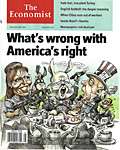 He returned to the U.S. in 1988 and joined the staff of
the Baltimore Sun, which laid him off after almost 20 years on staff.
Kal continues to cartoon for The Economist and for syndication with
Jerry Robinson=s Cartoonists & Writers
Syndicate/CartoonArts International.) He returned to the U.S. in 1988 and joined the staff of
the Baltimore Sun, which laid him off after almost 20 years on staff.
Kal continues to cartoon for The Economist and for syndication with
Jerry Robinson=s Cartoonists & Writers
Syndicate/CartoonArts International.)
Much of the crisis in American newspaperdom was self-inflicted by ambitious projects launched in the 1990s when profits ran into the 30-percent range; big city papers lavished these surpluses by building new printing plants and buying small newspaper chains, saddling themselves with a huge debt load that became nearly unbearable when the economy tanked at the same time that advertising revenues evaporated and readership/subscriptions declined. But the big city papers have dug themselves out from under by renegotiating with their lenders. The Denver Post dropped its debt from something in the upper $300-million range to about $160-million by Aselling@ some of itself to the lenders. Other papers have done the same. But the industry still seems bent on developing a digital future rather than re-affirming its print entity. Steven Brill, a journalist watchdogger of some repute, is one of three founders of a company called Journalism Online, which is devoted to showing newspapers how to charge for the online reportage that all papers have heretofore been offering without fee, thinking they could garner revenue from advertisers. Not so. Didn=t work out. So now, having given content away for nothing, newspapers want to reverse the trend and charge for the erstwhile free service. Brill and his cohorts are experimenting with ways to make the transition from free to pay. So far, about 1,500 newspapers have signed on to the service Journalism Online is offering.
EDITOONS OF THE MONTH R.J.
Matson=s melding of the BP logo with a picture of an oil-soaked
pelican might yet be the best over-all emblem of the disaster in the Gulf of
Mexico. 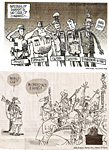 is an important ingredient in
single-panel cartoons, and this one is exemplary in that regard. We start out
at the upper left, reading the words; then we move to the right, picking up on
the usual Agestures of respect@ in the military, arriving, finally, at McChrystal=s gesture, by which time we realize just how far out of
line he was. Nicely done. is an important ingredient in
single-panel cartoons, and this one is exemplary in that regard. We start out
at the upper left, reading the words; then we move to the right, picking up on
the usual Agestures of respect@ in the military, arriving, finally, at McChrystal=s gesture, by which time we realize just how far out of
line he was. Nicely done.
I love Mike Lester=s drawings, one of which appears below Keefe=sCthe spidery line, the pancake flat feet, the big noses, and, here, the skeletal hands waving in the air. His pictures are enough to make me laugh. Here, however, I think his message is offCthat is, veering pretty far from reality. He suggests that the Taliban approve of the firing of McChrystal because he was such a potent threat to them. They feared him, and now that he=s gone, they rejoice. Well, I don=t know about that. I don=t think he was so successful that he was widely feared by the Taliban. But then, I doubt that the Taliban would admit to being afraid to begin with. Besides, since McChrystal=s replacement, General David Petraeus, is as much an architect of the strategy in Afghanistan as McChrystal, how could the Taliban think the threat (if they perceive one) has disappeared? Lester is the only commentator I=ve encountered who seems to be in favor of keeping McChrystal at his Afghan post. Every other noise of the gasbaggery has endorsed O=Bama=s firing of the General. Even George Will, stalwart of the Right. In his column last week, Will cautioned those who believe that McChrystal is Aindispensable@: AAny who may say that should heed the words of another general, one of the 20th century=s greatest leaders and realists. Charles de Gaulle said: The graveyards are full of indispensable men.@ About the firing, Will also notes a Athought@ that he can=t suppress: AMcChrystal=s disrespectful flippancies, and the chorus of equally disdainful comments from the unpleasant subordinates he has chosen to have around him, emanate from the toxic conditions that result when the military=s can-do culture collides with a cannot-be-done assignment. In this toxicity, Afghanistan is Vietnam redux.@ At the same time, Petraeus has now been elevated to America=s Supreme Hope. His abilities, political, military and personal, have been extolled in the most reverential terms. At such an altitude, the only direction is down. As we all realize, he=s being set up to tear down. O=Bama, remember, started his term as president with 70 percent approval rating; now, 47%. So with Petraeus, we=ll once again no doubt be treated to the spectacle of a once-admired personage being unhorsed by some mild miscue (or, even more likely, a change in fickle public approval) and then, subsequently, dumped to the accompaniment of as much high-sounding and self-serving demagoguery as our fearless leaders can muster to the task. Alas.
CIVILIZATION=S LAST OUTPOST A set of three chest x-rays of Marilyn Monroe=s upper epidermis sold at auction on June 27 for $45,000. I suppose that it=s inevitable in these days of our culture=s mammary fixation that MM=s torso should get all the glory, but I never thought her bosom particularly bountiful or unusually extra-specialClike, for instance, Sophia Loren=s or Raquel Welch=s. Or, to return to the days of Marilyn=s glory, Tempest Storm=s. It was MM=s caboose, remember, that attracted all the attention at first: Monroe walking away was a carnival of motion, her unfettered buttocks behaving, as they say, like a couple of puppies cavorting under a blanket. Well, maybe they didn=t say that; but they were thinking it. The original, handwritten (by John Lennon) lyrics to the Beatles= AA Day in the Life@ sold at a Sotheby=s auction for $1.2 million, beatling the previous record of $1 million for the Beatles= AAll You Need Is Love.@ ... Larry King says he=s hanging up his suspenders in the fall, ending a record-setting 25 years hosting the longest-running show on the same network at the same time slotCall those qualifiers effectively eliminate from consideration anything not named ALarry King Live.@ According to Pew/Smithsonian Magazine, cited in The Week, 58% of Americans expect that by the year 2050, there will be another world war; and 41% believe Jesus Christ will return to Earth by then. The question, of course, is: Whose side Jesus will be on in the war? Here=s one you may have heard: a guy at a diner orders a cup of coffeeCno sugar, no cream; and the waitress says: ASorry, we don=t have any cream; how about no milk instead?@ Ba-dum.
OUT CHICKWEED LANE WAY The comic strip 9 Chickweed Lane, one of the medium=s stellar performances, will be 17 years old July 12. AIt began in 1993 with Edda and Amos at 12 years old,@ said the strip=s creator, Brooke McEldowney. At the time, he Ahad no intention of letting them age, nor of writing any more than a gag a day.@ Since then, as we have observed here from time to time, he has told some whoppers, continuities that have expanded considerably on his original idea. As I type this, he is well into the ninth month of a story about Edda=s grandmother=s adventures in World War II. On today=s newspaper funnies pages, a continuity of such length is unheard of. Syndicates try to confine stories in continuity strips to six weeks or less. And gag-a-day strips, if they attempt any continuity at all, it=s thematic not narrative, and it=s confined to a week. AI=m not certain how much longer the story will go,@ McEldowney told me, Abut I'm nearing the denouement. That much I sense. I suppose it may have another month, perhaps, although it is hard to say for certain AI had no idea, when I started Edie's tale, how long it might go,@ he continued. AAfter the >We'll Always Have Brussels= story [in which Edda and Amos find carnal bliss at long lastCon top of a piano, I think it was, in full view of a passing dirigible full of eyeballing tourists], which stretched over a year (I believe), I knew anything was possible. I've certainly never seen so much mail as I have received for the present story (>Edie O'Malley U.S.O. Singer and Allied Spy=). And it certainly tells me a lot about conventional wisdom concerning spinning tales in a daily strip (by which I mean, if the wisdom is conventional, it is not wisdom, and it is definitely wrong). Had I informed anybody at my syndicate about what I was planning to do, they would almost certainly have restricted it in countless ways. I think the main thing is to ask nobody anything, especially as regards duration of a story. And never, ever, above all, tell them it will involve sex.@ He went on: AWhat I have taught myself about long-form stories is that comic strip cobblers have to emancipate themselves from the feeling that we write for panels, rather than for characters. When I compose these stories, I begin by seeing the entire thing cinematically, then I evolve dialogue without reference to graphic presentation. After awhile, the scenes just adjust themselves to their ultimate presentation. One scene between characters can take place over six days, and, somehow, build in tension all along the way. The thing that gets in the way of all this is the syndicates' and newspapers' and journalism schools' dogged underestimation of people who read. My advice is, never buy into it.@
PITHY PRONOUNCEMENTS ARetire? If you retire, you can=t ever have a day off.@CArt Linkletter; as for me, your faithful correspondent, I failed retirement. Contemplating Elena Kagan=s candidacy for the Supreme Court, Senator Charles Schumer mused that the hearings have Athe potential to be like eating spaghetti with a spoon: it=s a lot of work, and it=s hard to feel satisfied at the end.@ ANo one party can fool all of the people all of the time. That=s why we have two parties.@CBob Hope AThink fo yourselves and let others enjoy the privilege to do so too.@CVoltaire
LONG FORM
PAGINATED CARTOON STRIPS Joe Sacco=s massive Footnotes in Gaza (430 8x11-inch pages, b/w; Metropolitan Books hardcover, $29.95) is a terrible book. It=s terrible because of the horrors it depicts and because Sacco spins his tale in such a gripping and suspenseful manner that I couldn=t put the book down. No one likes to be held captive (but surely this is the best way for it). Sacco has been criticized in some quarters for the subjectivity of his reportage: he displays an untoward sympathy for Palestinians and a barely masked hostility for Israeli occupation policies. In the U.S. with its empathetic relationship to the state of Israel, Sacco=s rhetoric is deemed unacceptable by manyCalthough if he reversed his posture, he would doubtless be congratulated for his objectivity, such are the underlying biases of our time and our country=s attitudes. And it was to correct this bias that Sacco has spent so much energy on cartoon reportage about this fraught region. Gaza, which has lately become once more visible in the news because of the Israeli attack on a flotilla of ships allegedly carrying aid to the blockaded Strip, is probably not fit for human habitation. Here are a couple paragraphs from a report on the Asituation@ in Gaza published in The Week (June 25, 2010): AGaza is a humanitarian, an economic, and a political disaster. Only 26 miles long and seven miles wide and wedged between Israel, Egypt and the Mediterranean Sea, the Gaza Strip is only about twice the size of Washington, D.C. With a population of 1.5 million, it=s one of the most densely populated places on earth. Most residents are Palestinian refugees in families that fled there when Israel was established in 1948. Nearly half of Gaza=s population is under 15, and it has one of the highest birth rates in the world. (The average Gazan woman has five children.) While Gaza has a high literacy rate, unemployment runs as high as 40 percent, and 70 percent of Gazans life in poverty. ... [Gaza can=t feed itself because] it=s an economic wreck. In December 2008, Israel launched a three-week military campaign that destroyed much of Gaza=s infrastructure, leveling factories, government buildings, hospitals, schools and entire neighborhoods. Some 1,300 Gazans died and tens of thousands were left homeless. Israel=s stated goal was to weaken Hamas and reduce its capacity for terrorism. But in the process, says the International Red Cross, 96 percent of Gazan industry collapsed. AThe term >economy= is no longer valid in the Gaza Strip,= said Palestinian economist Omar Shaban.@ Just to unveil my own biasesCif they aren=t already apparentCI consider the foregoing an example of objective reporting. To some extent, this horrible predicament was created by Palestinian (or Arab) intransigence. In 1948 when the British abandoned its Amandate@ in Palestine after the United Nations created the state of Israel, five surrounding Arab countries attacked the infant nation; Israel, out-manned and out-gunned, nonetheless beat back the invaders. Thus, the plight of those who fled to the Gaza Strip (which was, for a time, administered by Egypt) is somewhat self-inflicted. But their plight is real and inexcusable, regardless of its cause; people should not be treated as Gazans have been treated. (Incidentally, the U.N.=s solution to the 1948 Aproblem@ of Palestine is exactly what is now being touted as the solutionCtwo separate states, one for Israel; one for Palestinians. If the Arabian population of Palestine in 1948 had accepted the U.N. proposal then, we=d have avoided 60 years of now seemingly pointless conflict and bloodshed.) But in a way, we can=t blame the Arabian population of Palestine for rejecting the U.N. solution in 1948: from the Arab point of view, Atheir land,@ where they=d lived for centuries, had been Ainvaded@ by Jewish refugees from the European tragedy of World War II and the Nazis= Afinal solution.@ Why should Palestinians give up Atheir land@ to these Jewish come-latelies? This dismal history, however, is not part of Sacco=s tale in Footnotes. In this book, he sets out to discover what actually happened in two Gaza communities in November 1956. Passing references in various accounts of the time allude to wholesale killings of unarmed civilians by Israeli soldiers, who herded Palestinians into groups, lined them up against walls, and shot them all to death. These references, however, have been reduced to footnotes in the history of those times and places. Sacco plays poetically upon his footnotes conceit in the evocative opening sequence of the book: AThis is the story of footnotes to a side show of a forgotten war. The war pitted Egypt against the strange alliance of Britain, France and Israel in 1956; the sideshow was the ongoing raids and counter-raids across the Gaza border by Palestinian guerrillas and Israel forces; and the footnotesCwell, like most footnotes, they dropped to the bottom of history=s pages where they barely hang on. History can do without its footnotes. Footnotes are inessential at best; at worst, they trip up the greater narrative. From time to time, as bolder, more streamlined editions appear, history shakes off some footnotes altogether. And you can see whyChistory has its hands full. It can=t help producing pages by the hour, by the minute. History chokes on fresh episodes and swallows whatever old ones it can. The war of 1956? Huh?@ These narrative captions are accompanied by pictures of what was happening in Gaza during his research visits there in November 2002 and March 2003Ctanks rolling into Gaza, Apache helicopters careening overhead, gunfire all around. And the next morning, a report on tv of a suicide bombing in Jerusalem. AAnother footnote, another page,@ Sacco concludes, AChere, where the ink never dries.@ Footnotes is Sacco=s record of his search for what happened in those two Gazan communities in 1956: the record develops as a narrative tension between what Sacco sees around him in Gaza and what he hears from Aold men@ and Aold women@ whom he asks to paw through the rubble of their lives to verify the stories about what happened in 1956. What he sees is a captive population, unable to get to work without wasting hours delayed at Israeli checkpoints. He sees bulldozers destroying buildingsCdwellings and businessesCin Gaza because Israel claims terrorist snipers are shooting from them. He sees vistas of rubble and devastation, and with his painstakingly careful drawings, he shows us what he sees. What he hears is heartbreaking. But he tells us anyhow. Sacco is a conscientious and deliberate reporter. When one old woman tells him Israeli soldiers were shooting at her and her friends, Sacco interrupts: AShooting at you or shooting over your heads?@ She clarifies: AOver our heads.@ Either way, the women are terror-stricken. Those he interviews often tell conflicting stories, and Sacco must decide which of their eye-witness reports are accurate and which are polluted by the passage of time and flawed human memory. He sometimes doubts his decisions; two or three times, he reports the story his interviewees tell then says he was unable to find credible eye-witness support for the tale. But his method permits him to present faulty recollections as well as verifiable facts. Facts and corroborating fictions pile up together, an odious heap of testimony to man=s inhumanity to man. And sometimes he tells about Palestinians killing Israelis. No one is entirely guiltless in this terrible recital. Each side dehumanizes the other, turning opponents into unfeeling brutes. At the end of the book, Sacco collects Acullings@ from various official documents he consulted at the U.N. and elsewhere. These and quotations from newspaper accounts and transcripts of a few interviews he conducted with Israeli officials generally support the picture he provides in the preceding 389 pages. Sacco is relentless. Every page of the book, every caption, every picture, is a grim recital of deprivation, grief and anger and, sometimes, violence. His pictures, I am persuaded, are accurate; their source, photographs Sacco took as he scoured the countryside and interviewed victims. It=s obvious that in drawing the book, he copied his photo sources as exactly as he was able to. Street scenes and cityscapes are endlessly crosshatched; the visual detail is exhaustive and impressive. Mob scenes are masterfully drawn, nearly overwhelming. But Sacco often tries to draw beyond his ability. His ability has improved since his earliest efforts at cartoon reportage, but he still has difficulty rendering faces at strange (though dramatic) angles, and his technique for casting shadows on faces is frequently clumsy. He depicts his witnesses as he saw them (and presumably photographed them) during interviewsCstraight on, from the front, the most monotonous, boring and worst possible angle for visualizing. Noses and chins have no dimension at this angle; everything is flat. Sidewalk caricaturists draw people in profile for a reason: that=s the best way to capture the size of individual features (say, noses) and their depth (brows) in relation to the rest of the face. Ditto three-quarters view. But Sacco persists in straight-on depictions. The technique, however uninteresting pictoriallyCparticularly when the speaker testifies for a long time and his or her picture appears repeatedly in uninterrupted succession with little variation in expressionChas a rhetorical effect in the narrative: the bleak and joyless life being recorded is underscored by the stark visual monotony of the pictures. Sacco=s own self-portrait also functions rhetorically in the story. His picture of himself is a caricature rather than a portrait: he gives himself a moon-faced visage, wearing spectacles that are opaque shields, no eyes visible behind them. The cartoony Sacco is in sharp contrast to the copious realism all around him, a comical figure adrift in an ocean of realistic misery. The maneuver, although somewhat clumsy, emphasizes Sacco=s role as outsider: he is not a part of the community in which he submerges himself momentarily, picking up scraps of an otherwise vanished history. If he is not part of it, does that mean he can see it more clearly than those who live in it? How can he see without eyes? If the opaque eyeglasses make us wonder at the accuracy of his vision, of his perception, his pictures counteract the impression. The seemingly unseeing reporter leaves us no choice but to look at his pictures and to accept them, their exhaustive detail persuading us that they are accurate and therefore true. This interpretation belabors a commonplace pictorial deviceCeyeglasses without eyeballsCconjuring up a complicated bit of visual rhetoric probably in excess of Sacco=s purpose in deploying it. So what was his purpose? Can we divine it from the pages before us? The cartoony caricature was perhaps concocted in the beginning, years ago, as a way of minimizing Sacco=s role in the narratives: turning himself into a cartoon is a way of disparaging himself, laughing at himself, which, in turn, down-plays his role in the proceedings. The maneuver also reveals something about how Sacco feelsCor feltCabout the work in his formative endeavors. Martyn Pedler at bookslut.com notes that Sacco felt ambivalent about how seriously his effort would be taken in the form of a Acomic book.@ Said Pedler: AWhen interviewing subjects for Palestine, Sacco didn=t admit that it was for a comic book. He was still >sheepish and unsure= about the whole idea@ of comic book journalism. A cartoony self-portrait in the narratives gave Sacco an escape clause: if people were scornful of his book, he could claim, pointing to his cartoony self, that it was, after all, just a comic book. See?Clook at the funny man. Now after accumulating awards and recognition, Sacco doubtless feels more confident about how his audience will perceive his work. But he perpetuates the cartoony Sacco partly out of habit: his cartoony self is now a well-established tradition in his reportage. And by contrasting visually with the rest of the people he depicts, his cartoon alter ego emphasizes his being an outsider, a useful posture for his argument. That much, I=m pretty sure Sacco would agree with. The unseeing eyes forcing us to rely entirely on the pictures? That=s more my fanciful interpretation than Sacco=s. But then, a critic=s fancy is not necessarily wrong. Mark Twain never thought his Huckleberry Finn was much more than a simple story; it took a couple generations of critics to change that perception. I wondered, as I came to the end of Sacco=s Footnotes, whether the story could have been told in any other medium. I suppose it could have been. Sacco=s photographs, for instance, could have been published in narrative sequence with explanatory captions. A motion picture could do as much. But neither of these methods would work quite like Sacco=s comic book. I decided finally that Sacco=s Acomic book@ was a unique way of telling the story. No other medium could achieve quite the effect he gets here. In translating photographs to drawings, he selected what to depict and what to emphasize; and that determined the work=s rhetoric. Presumably, he didn=t leave out much in the translationCcertainly nothing vital to the effect he was engineering. Moreover, cartooning in print is a static medium: the Aaudience@ can pause and study visuals and form impressions at leisure, possibly making the impact more lasting. Finally, the tension between word and picture capitalizes upon the static circumstance and creates a narrative mode that is deeply engaging. Sacco=s pictures often add information to the verbal recital: the pictorial information is sometimes more emotion-packed than the terse accompanying captions. The contrast makes us pause and absorb the implications. Pausing, Areading@ picture and prose, pondering their differences as well as their parallels, we are more engaged in the narrative than we would likely be sitting in a theater watching a movie, the images of which would slip quickly by, not permitting us to pause and ponder. And a book of photographs, no matter how sharply focused, could not give us quite as much noticeable detail as Sacco=s painstaking drawings. All of which, however obvious on the surface, is still a subcurrent in Sacco=s most noticeable device. By turning the story of two mass murders in two communities 50 years ago into a detective storyCthe story of a reporter=s search for facts and truthCSacco has created the dynamic of his work, a dynamic that is so compelling that it won=t let you put the book down. Now, here, by way of conclusion, is a gallery of images from the book, sometimes with a footnote of my own.
READ AND RELISH AZombies, as I have noted before (and before and before), make excellent movie creatures because they are smart enough to be dangerous, slow enough to kill and dead enough we need not feel grief.@CRoger Ebert To which George Romero, whose ANight of the Living Dead@ in 1968 inaugurated the vampire/zombie craze, added: AMy zombies will never take over the world because I need the humans. The humans are the ones I dislike the most, and they=re where the trouble really lies. The zombies are just [swats at the air] mosquitoes.@
FUNNYBOOK
FAN FARE An admirable first issue must, above all else, contain such matter as will compel a reader to buy the second issue. At the same time, while provoking curiosity through mysteriousness, a good first issue must avoid being so mysterious as to be cryptic or incomprehensible. And, thirdly, it should introduce the title=s principals, preferably in a way that makes us care about them. Fourth, a first issue should include a complete Aepisode@Cthat is, something should happen, a crisis of some kind, which is resolved by the end of the issue, without, at the same time, detracting from the cliffhanger aspect of the effort that will compel us to buy the next issue. In the Astonishing X-Men: Xenogenesis No. 1 (of a 5-issue series), Warren Ellis offers one of his customary intriguing beginnings: we see a raggedy man running through the woods and undergrowth, pursued by various armed personages who threaten to blow him to smithereens, and the sequence ends with him begging, ADon=t ... don=t make me ... please don=t make me ...@ Then with the turn of the page, we=re in the midst of another scenario altogether: a child is being born someplace in Africa, where the dialogue between the delivering mother and the expectant father is suffused with Ellis wit: She: ARaaaaCI can=t believe I let you put something the size of a goat=s head inside me!@ He: AI didn=t know the condom would split. My father had used it for twenty years without a problem.@ And then, Ellis abandons his narrative again, shifting to a roomful of X-Men who have been invited to investigate strange mutant births in Africa, of which, we eventually decide, the aforementioned birth was one: that scene ends with the baby exploding. After a certain amount of bickering, the X-Men decide to go to Africa, thus ending the inaugural issue=s episode. Apart from the wit displayed in the delivery room, the issue=s most astonishing feature is artist Kaare Andrews= affection for Emma Frost=s boobs, which, as we see here shimmering in red, hang over virtually every scene that she appears in, continuing to the cover of No. 3, which we=ve also reproduced nearbyCby way of keeping you fully informed as to what this series is all about.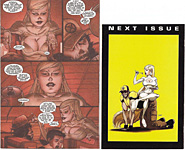
When the X-Men land in Africa, they are immediately surrounded by armed soldiers, a sufficiently suspenseful moment to insure our purchase of the next issue (if Emma Frost=s bosom isn=t enoughCalthough how, given its amplitude, could that possibly be?). By the end of the second issue, we still don=t know who the running raggedy man opening the first issue is.
***** Buzzard No. 1 (of a 3-issue series) is another brand of Goon from Eric Powell, lots of atmosphericsCa beak-nosed old man wearing a witch=s hat and riding a dead horse talks in a pretentious biblical-like manner: AI was not surprised by this outcome, but again, I knew not why. I mounted the ghastly beast and rode forth through the mist.@ Which declamation is accompanied by a picture showing him riding the dead horse through the mist, a classic case of visual-verbal double exposure, both words and pictures doing the same narrative job. The Buzzard comes upon a village being terrorized and undertakes to rid it of the terror, Asome kind of monster god or spirit that held sway over these parts and would kidnap the menfolk@ and turn them into one of those mangled hairy creatures the Buzzard killed and ate on the town=s outskirts before he knew any better. The episode, the Buzzard=s defeat of one of the mangled beings, isn=t enough to make me return, chiefly because I=m not impressed with the title character. Too much spook and not enough personality. The issue concludes with a 6-age ABilly the Kid=s Old Timey Oddities & the Pit of Horrors@ by Powell with art by Kyle Hotz. More spooky stuff that doesn=t appeal to me, but there=s at least one good visual interpretation of the Kid. ***** Ron Zimmerman returns with the Gay Caballero in Rawhide Kid : The Sensational Seven No. 1, this time rendered by Howard Chaykin, whose dedication to all sorts of sexual innuendo well suits him for the task at hand, which is mostly making the Kid smirk slyly as he delivers an assortment of homosexually-laden quips while rescuing a toothsome Annie Oakley in her undies; she=s locked herself in the local hoosegow in order to evade the unwanted attentions of a town full of lustful thugs. These the Kid cows into submission through the sheer force of his personalityCnamely, his fists and six-guns (two)Ccompleting one of the issue=s several episodes. Annie enlists the Kid=s help in rounding up a passel of rescuers to get Wyatt and Morgan Earp out of a jail somewhere in the South; presumably, in the tradition of a Yul Brenner western, they=ll find five more variously-talented roughnecks who will form the band that does the deed. Lots of funny stuff here, much of it visual. And Chaykin goes all out with his drawings (apparently not suffering the same revulsion at the subject that John Severin seemingly felt in the previous outing), strangely embellished with variant tonal emanations by colorist Edgar Delgado, who performed the same service with last year=s Dominic Fortune series. Zimmerman=s previous foray into gaiety with the Rawhide Kid I was appalled at because it perpetuated every homosexual stereotype known to bigots. Apparently gays were not offended by this extravagance; indeed, humor among gays often deploys these self-same stereotypesCand they=re back again in this book. If nothing else, the Kid proves with physical prowess that faggots are not sissies. In any event, I=m aboard for the rest of the ride, even as the Kid, slipping on a pair of anachronistic shades, saddles up and dashes off on the last page of this effort. The earlier Zimmerman effort, Rawhide Kid: Slap Leather, is now available as a trade paperback (120 8x10-inch pages, color; Marvel, $24.99). ***** Dracula No. 1 (of a 4-issue series) is apparently a reprint of Dracula Lives Nos. 5-8, subsequently reprinted in Stoker=s Dracula No. 1. Written with his usual skill at adaptation by Roy Thomas and drawn by the late Dick Giordano, for the sake of whose copiously modeled and cross-hatched art I bought this first issue. Lots of shadows and creepiness, just what every vampire fan dotes on. ***** I=m coming in several eons late with DV8: Gods and Monsters No. 1 (of an 8-issue series), which takes up the adventures of this team of superheroes as one of them, Gem Antonelli (aka Copycat) is being prevailed upon by her captors to tell what happened. What happened, it seems, is that she and the rest of the gang have been dropped into the midst ofCsomewhere?CAon recon.@ Various of them wander off into the foreboding landscape, becoming Agods,@ which is what happens to people with superpowers in the Stone Age, which is where, apparently, they all are. The central episode might be Leon (aka Frostbite) Carver=s rescuing of Gem when she recovers consciousness after her fall from the sky into the midst of a bunch of battling Stone Agers. As narrator, Gem earns our sympathy and, hence, enough interest to get us to the second issueCeven though (1) there are too many characters here with picturesque super-names to keep track of and/or appreciate (Ero, Sublime, Threshold, Bliss and Freestyle in addition to the aforementioned Copycat and Frostbite) and (2) so many mysteries (where is Gem being kept? how=d she get there?) that we can scarcely focus on one enough to be provoked into a state of suspense. ***** One last
time, we have Amanda Conner on Power Girl: with No. 12, she bows off
stage, leaving several of us weeping uncontrollably. As a finale, this is
fraught with sentimental sillinessCPG and her good bud, Atlee, visit the
latter=s home town for a little R&R (that=s Arest and relaxation@ not Arants and raves@), then PG goes home and feeds her nameless cat, forgives
the adolescent Fisher for taking unauthorized photos of her en deshabille,
rejects the lusty interplanetary hairy sex fiend Vartox one more time, and goes
to her office where her staff throws her a surprise birthday party (it=s a surprise because no one knows when her birthday is).
Power Girl, just a little home body. But Conner and her cohorts arrange on this
last collaboration on the character to reveal more of her body than usual as PG
tries to squeeze her generous proportions into an itsy-bitsy, teenie-weenie
swimming suit; the sequence also includes a nifty waterfall sceneCall of which, we display here.
***** It was Scott
Campbell=s cover (naturally) that seduced me into buying Marvel
Divas No. 1. In one of my earlier lives, I swore I would not be suckered
into buying books based upon the spectacularity of cover art done by someone
who doesn=t draw the insides. But this I couldn=t resist. And I=m glad I couldn=t: the interior pages, rendered in graceful simplicity by Tonci Zonjic are every bit as gratifying to my wetly rolling eye as the
Campbell cover. This series seems destined to be about Arelationships,@ a word I find extremely threadbare as a substitute for Alove affairs@ or Amarriage,@ but the dialogue crackles with snappy patter and sly humor, and the drawings are delicious, so I=ll be back for more. ***** Speaking of
silliness, here=s a one-shot reincarnation of Fin
Fang Four Return, which I picked up mostly because Roger Langridge drew
it. The rest is nonsense of the first water. Here=s
a page of Langridge.
***** Skottie Young=s cover for Iron Man: Armor Wars No. 1 (of 4) also captured my attentionCand my three bucksCwith its raw sketchiness. And Craig Rousseau=s drawings inside, while of an entirely different sort altogether, are equally pleasing to the eyeCclean and spare with brilliantly highlighted colors on the armor by Val Staples. Joe Caramagna=s story has Tony Stark living in Los Angeles where he=s given up making weapons, much to the consternation of his numerous supporters and government contracts office, but it may be that Stark can=t give it up. In the issue=s central episode, he survives an annoying assault by the armored Crimson Dynamo. And in the suspenseful conclusion, when he is assaulted by a woman wearing the Iron Man suit, he survives thanks to his extensive knowledge of how the armor works: he manages to turn it off. But the errant female, it seems, has powers beyond those of the suit, and as she flies off in a rage, Doctor Doom towers over Stark, gloating: AYou call yourself a hero?@ ***** I picked up Tom Strong and the Robots of Doom No. 1 (of 6) because Chris Sprouse is penciling; Karl Story, it turns out, does a masterful job inking. After that, though, I=m a little lost. Peter Hogan is telling one of those disjointing time-travel tales in which Tom Strong must confront and triumph over his own illegitimate son, Albrecht (using the last name Weiss, a fact that may or may not be important). At the beginning, Tom and his wife (not the one that=s Albrecht=s mother) are contemplating the forthcoming nuptials of their daughter, Tesla, and then the whole enterprise folds in on itself and we learn that Albrecht and his mother, an earlier paramour of Tom=s, have traveled back in time, then forward, to achieve the Nazi vision of the world. The explanation of this feat constitutes the issue=s central episode, after which, we, and Tom, wonder what has happened to his present wife and Tesla, who, because of the adjusted wrinkle in time, no longer exist. Right? Ingrid, Albrecht=s mother, tries to seduce Tom, who is chained to a wall, and there are some fetching pictures of her sauntering around the cell in her underwear, but Tom, chained, as he is, to the wall, can do littleCeven if he wanted to, which he doesn=t. She leaves, and a tear runs down Tom=s cheek. ***** The premise in Dead Run No. 1 (of 4) is that in a nuclear-blasted world of the future, a courier named Nick Masters is forced to make the Adead run,@ usually a mission from which no one returns, to deliver some drugs for arch villain Kane, who has kidnaped Masters= sister as a way of persuading the courier to undertake the suicidal task. Only Waylon Biggs, a creaky old geezer with an artificial arm, has successfully negotiated the Dead Run: he won=t help Masters, but in the issue=s central episode, his spunky daughter Becki volunteers to helpCprovided she can go along for the ride. The issue ends with Masters and Becki in his old car, poised on the brink of a cliff, as they begin their dead run. A real cliff-hanger. This is an old magazine, June 2009, so the story has probably concluded safely. But I was intrigued enough by Francesco Biagini=s drawings to pick the thing up; and then Andrew Cosby=s story hooked me when I read itCbut I didn=t do that until last week, so to find out what happens, I=ll have to explore back issue bins at Mile High Comics. ***** The Green Hornet books now piling up from Dynamite Entertainment are, alas, more baffling than engaging. I read the first two issues of Kato, which, pretty obviously, intend that Kato=s toothsome daughter will take over the sidekick role with Britt Reid=s lay-about son, who, we assume, is going to inherit his father=s Green Hornet mask and snap-brim fedora at some future point as yet too far in the distance to discern. That part of the story is being regaled in the pages of Green Hornet, with script by Kevin Smith and breakdowns by Phil Hester. In No. 2 of this title, we spend most of the issue listening to Reid pere and fils talk, sometimes together, sometimes separately (as when the senior Reid conducts an editorial meeting at his newspaper, where he reveals his propensity to use the paper=s pages to advance the political career of his aging friend rather than to report the newsCtypical). The central episode appears to be a contentious conversation between father and son in which the former castigates the latter for being a slacker. Too talky by far. But at the end, a voluptuous woman in a red dress shows up to attempt protecting a cocktail party=s attendees from an attack by masked ninjas. Among the attendees, both Britts, father and son, and the latter is duly impressed by the babe. The whole issue is much too overwroughtCflashy coloring by Ivan Nunes gives Jonathan Lau=s drawings a garish garnish. And the action of the last pages is (surprisingly, given Hester=s usual competence) all sound and furyClots of flinging around with the girl=s legs escaping her dress repeatedly, but the poses are not connected in any way that suggests continuity of action, which, I ween, should be fundamental to a fight scene. Or, at least, there should be enough of it to convey the impression that the combatants are not simply flying around the room. On the last page, Britt senior, eying the rampant beauty, says, AKato?@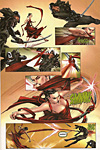
The distaff Kato is pictured in the traditional chauffeur=s uniform on the cover of Green Hornet No. 2, backing her boss, her bosom stretching the fabric of the tunic; but she doesn=t appear in the uniform inside. Inside, it=s the red dress with its fetching neckline. In fact, now that I look around, I see that Green Hornet and Kato (ften the babe version) appear on the cover of every one of this bunch of titles, but Kato never appears within. Good PR move, DECinspires confidence and reader loyalty. Putting one and one together, I assume that the babe in Green Hornet No. 2 is the now mature version of the adolescent sweetie we meet in the Kato books, the rebellious daughter of the original Green Hornet=s sidekick, who has retired and gone back to Japan. But this title, judging from the first two issues, is too confusing. The perplexity begins with drawings by Ale Garza and Diego Bernard. We meet two bare-chested male fighters working out in their private gyms. For a good number of pages, I thought they were the same guy: they look exactly alike in both body and face. (As do the women, all of whom have the same pert noses and well-rounded body parts.) The names Juuma and Kato are bandied about, but given the similar appearances of these guys, the names don=t help. Finally, upon close examination on a second reading, it seems one of the bare-chested guys has longer hair than the other. Ah, ha! The long-haired guy is Kato; the other guy is the revenge-driven son of a rival family, the Juumas, who is out to kill Kato and the Green Hornet. Adding to the visual chaos is the story=s narrative mode, flipping back and forth in time, hither and yon in locale. The toothsome daughter, Mulan, quarrels with her father because she=s not sufficiently dedicated to the discipline of shinto, and she flounces out to join some friends at a nightclub where she beats up several male admirers. Meanwhile, her father and his wife, another toothsome specimen, have a disagreement over child-rearing that ends when she takes her clothes off and leads her husband into their bedroom. Nice picture of her naked, from the rear. When we return from the nightclub where Mulan is working her magic, we see Kato meditating over a laptop, but when he goes to find his wife, he finds her dead, murdered by the vengeful Juuma guy. The next issue is devoted almost entirely to the fight between Kato and Juuma, with occasional flashbacks to Kato=s courtship of his now-murdered wife. This builds an emotional backwater that makes her death all the more poignant (although her naked backside is pretty poignant-provoking by itself). At least in this issue, Kato and Juuma are differently attired, so we can tell them apart easily. Eventually, I suppose, Kato will be killed by Juuma, and daughter Mulan will turn into another revenge-inspired fighter, from whence she=ll traverse to being young Britt=s sidekick (and probable lover?). Ande Parks wrote the Kato books, and the story is okay, although I think the whole revenge-wrought family feud thing is probably excessive. His story, howeverCalready confounding by virtue of its shifting time and place so frequentlyCis further undermined by the drawings, which, as I said, don=t distinguish characters one from the other. The second issue is drawn entirely by Bernard, who inked Garza in the first issue. Garza is the better artist, I=d say, judging from Bernard=s often awkward shadowing in No. 2. But Garza=s pencils are also those that make all women look the same sexy way; ditto the faces of the men, whose bodies, bronzed six-pack abs and all, are likewise indistinguishable. Or did I say that before? A third Green Hornet title that DE has set loose on defenseless newsstands is Green Hornet: Year One. This title is about the first generation Hornet and Kato. Script and Aart direction@ by Matt Wagner; pencils and inks by Aaron Campbell. Three stories transpire: in one, we witness the Green Hornet of the late 1930s dishing just deserts out to the gangsters who=re running guns in Chicago; in another, we see the self-same guy before he was Green Hornet, when he defeats some African thugs by setting a swarm of green hornets on them; finally, in the third tale, we see Kato, who manages to participate, with revulsion, in the rape of Nankin in 1937 China as the Japanese begin their conquest of the Far East, leading, eventually, to bombing Pearl Harbor and the ensuing World War II. The first two strands reach satisfying conclusions and are therefore complete episodes in themselves; the third leaves us wondering and eager for the next issue. Campbell=s drawings are Occidental in tradition, not manga-inspired as are Garza=s; nicely gritty evocation of the 1930s. Kato is with Green Hornet on the cover of No. 2, and he shows up to help the Hornet beat up the bad guys. A DE first for the series: a cover related, however distantly, to the interior action. This series of Green Hornet titles is fraught with motive for the initial teaming up of the Hornet and Kato, first generation; and for the eventual hooking-up of the second generation Hornet and Kato. The intertwining strands are fascinating, although I can=t help but wonder if all this prequel is going to be worth it: several titles, totaling six issues so far, all devoted to Abackground.@ And more titles are accumulating, day by day. I just saw one with the word Aparallel@ in the title. I suppose this onslaught of winged insects will never end, having, now, gotten itself into the atmosphere and air-ducts everywhere. When will we get to the Acontemporary@ adventures, and will they be worth waiting for? Who knows? I don=t. But the toothsome babe Kato is intriguing; ditto the slacker Britt Reid. Incidentally, does anyone beside me remember that the Green Hornet is related to the Lone Ranger? Both characters were created in the 1930s by George Trendle and Fran Striker for radio adventure programs. The Lone Ranger had a nephew named Dan Reid who showed up occasionally. In the Green Hornet radio programs, the Hornet=s father was likewise Dan ReidCthe same Dan Reid, it is usually supposed; Striker was certainly inventive enough to give the character a different name if he didn=t intend the relationship. That makes Britt Reid, the Green Hornet, the Lone Ranger=s great-nephew. ***** In Avengers Prime No. 1, ASiege: Aftermath@ in what I suppose is a new over-arching themeCAThe Heroic Age@Cwe find Iron Man (in his old armor) bickering with Steve Rogers in spandex (pretending not to be Captain America) about who left the Aportal@ open and whether it can be blamed on Norman Osborn. Or something equally inane. The main thing is that Asgard is in ruins and Thor, who=s also hanging around these parts, is sad about it. Rogers and Stark resolve to help Thor rebuild the place, but before anyone can do anything, the Abroken portal@ gets unhinged, and the three are transported to three different places. Iron Man is in the desert, all by himself except for the lurking menace that he doesn=t see yet. Rogers gets sent to some sort of troll fest, and when they attack him, he whips them all but still doesn=t know where he is. He picks up a round shield from one of the fallen and grabs another=s chain mailCand smiles. Meanwhile, Thor has been transported to Vanaheim where he has a violent encounter with someone trying to steal his hammerCand the Enchantress suddenly shows up, looming over Thor, her bosom majestic. It=s Brian Michael Bendis= story with pencils by the redoubtable Alan Davis, gleamingly, confidently, inked by Mark Farmer. The only episode here is the apparent end of the bickering that started us off. But the real treat in this book is the story at the end, AThe Coming of the Accursed Avengers@ by Ralph Macchio and Walt Simonson, a reprint of a delicious treatment of yore. Simonson=s drawings are a genuine treatCchipped line, crisp and crinkly. Ah, what I=d give to see more of it. ***** Who is Jane Vellez-Mitchell on Headline News and why is she always shouting at me? ***** Darkstalkers:
The Night Warriors No.
1 is another title I succumbed to because of the cover. Well, I said it was the cover that hooked me. And nothing happened in the story, except the artwork, to engage me further. But then, I was looking for a story, a comic book story, and this whole enterprise might actually be about a video game, just exactly the sort of modernity that always evades me until the very last minute. And, as you can tell, it does again here. ***** In Devil No. 1 (of 4), a vampire virus is raging throughout Japan, and various official law enforcers are trying to stem the tide. One of them, Okawa Takimoto, is a crude matter-of-fact gunsel, who wants to shoot the bloodsuckers and get them out of the way. The other, a fetching lass named Migiwa, is more humane and thinks of the vampires as suffering from some illness. Whether she thinks they can be cured or not we don=t yet know, but she=s all over Takimoto every time he liquidates one of the vampires. The central episode finds s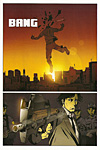 Takimoto defeating one of the worst kinds
of vampireCan S-class creatureCwho, it seems, was once a friend of his before he/it was
bitten and infected with a bloodlust that knows no assuaging. The storytelling
is the work of the artist, Torajiro Kishi, who manages a nicely terse
manner that elevates suspense by sheer constraint. There=s some very cinematic treatments and a few spectacular
pages of dramatic pictorial storytelling. Takimoto defeating one of the worst kinds
of vampireCan S-class creatureCwho, it seems, was once a friend of his before he/it was
bitten and infected with a bloodlust that knows no assuaging. The storytelling
is the work of the artist, Torajiro Kishi, who manages a nicely terse
manner that elevates suspense by sheer constraint. There=s some very cinematic treatments and a few spectacular
pages of dramatic pictorial storytelling.
***** Joe the Barbarian No. 1 is another exposition of spectacular drawing, this time by Sean Murphy, who writes in the issue=s editorial: AMy favorite part of the first issue is the interior of Joe=s houseCdated 70s furniture, faux wood paneling on the walls and shag carpeting. ... And his bedroom! I designed it to be the bedroom I always wanted when I was a kid: a cozy attic dwelling complete with a bunk bed, skylights, and a rope ladder. The rope ladder was [writer Grant Morrison]=s idea, but everything else in the house is mine. ... Grant left most of the details of the house to me, so I took the opportunity to try to shape that part of the script into something unique, different from the typical setting. ... I could have drawn a normal kid in a normal house and Grant=s writing would have sold it just fine. But by fooling around with my personal childhood nostalgia, I felt even more captivated by Joe and his world. I wish I could say that I planned it all along and that I=m a master storyteller, but the truth is that I fell ass backwards into it. And it ended up working outCat least for me.@ Dunno about the nostalgia partCmy childhood was a little different, with somewhat different daydreams (and no action figures)Cbut Murphy=s drawings work for me to a fare-thee-wellC stunning, a delicate mix of fineline and textures, exquisite in detail and refinements. You can get lost in Joe=s bedroomCor in any part of the rest of his home, or in the streets outside, orC. You get the idea. The book, as Murphy notes, tells a story Aabout a kid who sees his fantasy world come to lifeCa fantasy that=s Lord of the Rings meets >Home Alone.=@ Joe is something of a loner, a kid with artistic talent who reads and draws and is bullied by his classmates. The crowning episode in the first issue is when he is transported via one of those graphic swirling vortices into his fantasy world, where his toys are alive. It ends just as he falls out of bed (Little Nemo anyone?) and realizes that the things he=s seen at the end of the swirling vortex are his toys and action figures.
But it=s Murphy=s artwork, not Morrison=s tale, that engages and holds us. The Astory@ as it emerges in ensuing issues of the title, is a colossal jumble of arcane phantom places and mystic personagesCdying boy, skyland, lower kingdom, light of reason, army of the unnatural, fortress of discoveryCflung about with little regard for narrative cohesion. That=s what fantasyCer, dreamlikeCworlds are, right? In No. 4, we encounter a would-be wizard making this explanation: ASquare root of eye of newt, over function of the cosine where eee equals magic times the speed of all likelihood squaredCwith me so far?Cresulting in at least two isomorphically linked states of being as represented by these ellipses and where this circle represents the sum total of everything.@ A speech, I ween, that perfectly captures the mood and atmosphere of the entire enterprise. Joe, it seemsCinsofar as we can make any sense of nonsense at allCthreatens the fantasy cosmos because he exists in two worlds simultaneously, inadvertently unlocking a door into the Outer Murk. But nonsense though it is, Murphy=s surpassing drawingsCantic landscapes and towering architectures with numerous circular staircases and vast windows and Joe=s giant pet white rat wearing armorC make a believer of everyone here at Rancid Raves. Onward. ***** The Great Ten No. 1 introduces us to yet another team of superheroes, this one is Chinese, and the pages are encumbered with a lot of pictographic decorationCcute but it clutters the visual horizon. Herein we are regaled with the origin of the superpowered Accomplished Perfect Physician, who can, apparently, do anything. So why does the team need nine others? Cnamely, the August General in Iron, Thundermind, Celestial Archer, Immortal Man-in-Darkness, Ghost Fox Killer, Mother of Champions, Shaolin Robot, Socialist Red Guardsman, and Seven Deadly Brothers (if this guy is actually seven guys, then the number of the Great Ten is more like sixteen, sort of like the Big Ten being really eleven colleges, now twelve, but still being called the Big Ten). These team titles (Justice League, Justice Society, Avengers, X-Men and on and on and on) always remind me of the Grimms= fairy tales about AThe Six Servants@ and AHow Six Traveled through the World@ in which a half dozen personages, each with a different peculiarly unuseful skill, conquer all before them. In their adventure, each member of the team contributes his unique prowess to the assignment given the group, and thus the raison d=etre for the group is invoked and a moral propounded: no matter how strange your skill, it can be useful in the right circumstances. But funnybook superhero teams, it seemsCif we are to judge from the specimen at handCexist chiefly to provide personnel for quarreling. No moral fiber at all. The bickering ends in this inaugural issue when the combatants are interrupted by the arrival of another team, this one numbering merely eight but they=re all godsCKuan Ti (God of War), Jade Emperor (King of the Gods), Gong Gong (God of Floods), Lei Zil (Goddess of Lightning), Chu Jung (God of Fire), Lei Kung (God of Thunder), Chu Jiang (God of the Dead), and Feng Po (God of WindCso he vanquishes his foes by breaking wind?). The advent of this bunch is heralded by the August General in Iron, who, speaking into his forearm, summons the others: AThis is the August General in Iron,@ he intones, ACwe are at Threat-con One! All members of Great Ten converge immediately on my coordinates! We are facing a Level-Five Threat!@ WaitCI thought it was Threat-con One. So Threat-con One is invoked when facing a Level-Five Threat? Tony Bedard=s story is given an enjoyable visualization by Scott McDaniel on pencils and Andy Owen in ink, but their performance cannot rescue the idea=s rapid disintegration into utter nonsense. OrCmaybe this is just another video game? Or perhaps DC=s opening gambit in an invasion of the Chinese mainland with funnybooks galore. Stay =tooned.
WE=RE ALL BROTHERS, AND WE=RE ONLY PASSIN= THROUGH Sometimes happy, sometimes blue, But I=m so glad I ran into you--- We=re all brothers, and we=re only passin= through. AL WILLIAMSON The first
time I saw Al Williamson in the flesh, he was laughing uproariously. We=d just been introduced, and we were in the lower lobby of
the Hyatt Regency near Chicago=s Ohare airport; Al=s raucous outburst was occasioned by Batton Lash, who, in
approaching Al from across the lobby, had become entangled with a potted palm
and was apparently going to wrestle it to the floor. Batton=s wife, Jackie Estrada, was trying to extricate her
husband from the clinging fronds, and Al was pointing and laughing, his head
thrown back, white mane a-flourish. Al liked to laugh, and he found lots of things to laugh about, some of them his own witticisms. He also liked to swear, and his conversation was liberally dosed with Agoddamns,@ Ashits,@ and Afucks,@ always delivered with a broad grin or a burst of laughter. His swearing was not serious: it was punctuation. Later, I decided that his profanity was part of a pose he assumed in publicCa macho roughhouse persona, rude and crude masculinity that masked his real character, an artistic and personal sensitivity honed to the point of insecurity. That evening, a bunch of us all went to dinner at an otherwise forgettable restaurantCAl, Batton, Jackie, my friend John Bennett, and Tom Roberts, even then working on his biography of Alex Raymond. And one or two others. We were all attending the Chicago Comic-Con (it was not yet the Wizard Con), but the talk around the dinner table was mostly about old movies, which Al and all the rest liked. My idea of an old movie was ABambi,@ so I didn=t have much to contribute. I ran into Al twice at breakfast on succeeding days. The first time, he was with Archie Goodwin and invited me to join them; I did. Archie told about how Andy Warhol, then unknown, had once applied for art assignments wherever it was that Archie was working as an editorCprobably Warren=sCoffering as samples of his work some drawings of sneakers and shoes. Later, he would become famous for, among other things, drawing footwear. They talked a little about EC and Bill Gaines, and I asked Al to sketch a floorplan of the EC offices on Lafayette Street just south of Houston in Manhattan. I don=t know where that treasure is, but it scarcely matters: Al kept changing the drawing as he remembered other nooks and crannies of the place. It was soon just a scribbleCa good visual aid to an oral description but no longer a stand-alone diagram. The next morning, I found Al breakfasting by himself, and he again invited me to join him. We were making small talk about comic conventions when he made a startling statement: he suddenly exclaimed in amazement: AThese people at these conventionsCthey like me, they like my work!@ Then, just as suddenly, he changed the subject, deploying an awkward conversational gesture as if to say: AOoopsCI didn=t mean to say that and I shouldn=t have.@ In a few seconds, he had revealed the shy boy hiding in the body of the blustering profane man, the insecure youth of yore who had found himself in the company of such artistic giants as Frank Frazetta, Roy Krenkel, George Evans, Reed Crandall, Angelo Torres, Gray Morrow, Wally Wood and others of that stripe. AA remarkable number of Al=s friends are accomplished artists,@ S.C. Ringgenberg wrote in Hidden Lands. AWilliamson worked with more great comics illustrators than perhaps any other cartoonist of the day. You could certainly never fault Williamson for his taste in sidemen.@ In talent and skill, he could match them, but he had a tough time believing it: many of the early stories he drew for EC and elsewhere, he abandoned after penciling them: he was afraid he=d ruin the drawings by inking them himself and so turned them over to one of the illustrious others to finish. If he was shy and even a little insecure, few knew it: he covered it up with sheer chutzpahCthat and talent. Wally Wood remembered: AHe was very cocky, boisterous, and a lot of fun. He used to walk into the Hogarth school (aka the School of Visual Arts) where all of these older guys were learning how to draw, and he was a pro! He=d walk in and say, >Hello students!=@ Marie Severin remembered that at EC AAl was like a breath of fresh air. It may have been Moon air or Mars air, but he had a nice freshness about him.@ Al=s diffidence lurked just below the surface of his rowdy persona most of his life, I=d guess. I found myself one evening at some later Chicago Con again in Al=s company, this time when Mike Richardson was buying dinner for a gaggle of people that included Al and John Romita Jr., who were seated across from each other at a long table. I was nearby and heard Al diffidently offeringCaskingCto do more inking for Romita. Seriously, gently, without a swear word or a laugh. By this time, he was confident of his surpassing ability. He=d drawn Secret Agent Corrigan for Goodwin=s scripts for thirteen years, a tour de force. He=d reincarnated Alex Raymond=s Flash Gordon several times. He was a past master, a towering talent, a giantCa legend. And yet, he seemed almost to be the supplicant in saying that he=d like to ink Romita=s pencils again at some future time. I ran into Al at various times during three or four Chicago Cons. Once several of us sat in the lobby of the Softel late at nightCSergio Aragones was in the group. You=d think a conversation involving Sergio Aragones and Al Williamson would be epic. But it wasn=t. It flagged. It came in short bursts, followed by laughter that faded too quickly, embarrassingly quickly. Then a long silent pause. Sergio was in awe of Williamson as much as the rest of us were, and we all sat there, waiting for the great man to impart words of wisdom. That, however, was not Al=s manner: he found his comfort being in company, not being on a pedestal before it. The last time I saw Al was at the San Diego Con. I saw him at a distance in the vast lobby of the cavernous convention center and ran up to him, extending a hand and saying, AHi, AlCgood to see you.@ I was met with an uncomprehending stare and a blunt, AWho the hell are you?@ I thought he was joking at first, but when I realized, almost at once, that he wasn=t, I excused myself and walked away, thinking I may have deserved the rebuke: I was scarcely an intimate friend despite my having spent several hours in his company at various times, despite the friendly and respectful inscription on a Secret Agent original he=d given me. I learned later that Al was in the early clutch of Alzheimers. I never saw him again, and I suspect he didn=t attend any comic-cons after that. The fan press never found out about the Alzheimers; or if it did, it never announced it. As far as I know, Al=s friends never told anyone except other friends, and we all kept quiet. The first news of his death arrived as a Anews release@ from his wife Cori and his family, sent out by Ray Cuthbert. Here it is: ***** AL WILLIAMSON, who for over fifty years drew for both comic books and comic strips, died June 12, 2010, at age 79. In recent years he suffered from Alzheimer's disease. He is survived by his wife of thirty-two years, Cori, his daughter Valerie and his son Victor. Williamson was born in New York City in 1931, but spent his first thirteen years primarily in Bogotá, Colombia. In 1941, his mother took him to see the science fantasy movie serial AFlash Gordon Conquers the Universe,@ an experience which, combined with his love for comics storytelling, set his career course at an early age. Williamson, who first and foremost considered himself a cartoonist, excelled at illustrative science fiction, adventure and western stories, pulling inspiration from both classic comic strips and motion pictures. He is highly regarded both popularly and critically for his excellent draftsmanship and dynamic storytelling. Most notably, Williamson was extraordinarily accomplished at rendering the human figure in motion. His classically proportioned characters twist and leap with a startlingly vivid illusion of movement in part evolved from his study of motion picture action choreography. Williamson began his professional career in 1948 and achieved popular recognition in the early 1950s as the youngest and one of the most talented contributors to the legendary EC line of comics. Beyond EC, Williamson drew superior work for many comic publishers, including American Comics Group, Atlas/Marvel, Charlton, Classics Illustrated, Dark Horse, Dell, Harvey, King, Prize, Toby and Warren. From 1967 until 1980 he produced the art for the King Features Syndicate's daily Secret Agent Corrigan newspaper strip, and from 1981to 1984 drew the daily and Sunday Star Wars newspaper strip. Beginning in the 1980s Williamson reintroduced himself to a new generation of comics readers as an inker for DC and then Marvel Comics, enjoying memorable stints finishing the work of other artists on Superman, Daredevil and Spidergirl. The single comics character, however, with whom Williamson is most identified would be Flash Gordon. The science fiction adventurer, created in 1932 by Alex Raymond for King Features, engaged the lifelong imagination of Williamson. He produced a much beloved series of Flash Gordon stories for King Comics' Flash Gordon comic book in the 1960s. He returned to the character in 1980, drawing a comics adaptation of the contemporary Flash Gordon motion picture. In the 1990s, he produced a Flash Gordon mini-series for Marvel Comics and later contributed to the original Sunday strip. In addition to the stories, he produced countless other Flash Gordon images for uses in advertising, merchandising and the fan press. He gradually retired from the professional ranks in the early years of the new century as one of comics' most admired and influential creators. Over his career he received numerous professional awards, including multiple Harvey and Eisner Awards and the National Cartoonists Society's 1967 Award for Best Comic Book Cartoonist. Beyond his remarkable accomplishments as an artistCthe works mentioned above represent only a samplingCWilliamson deserves recognition as a veteran who often opened professional doors for many others starting their careers. An impressive number of comics contributors owe at least part of their success to Williamson's willingness to recommend and promote new artists and writers to his editorial contacts. Williamson was also an avid collector of comics and illustration art, valuing the beauty of original drawings produced for comic books and strips long before the physical art created by commercial artists was popularly appreciated. He will be fondly remembered by those you knew him for his generosity, his indefatigable sense of humor and his great enthusiasm in sharing his love of comics, illustration, movies and music. Al Williamson took inspiration from a legion of cartoonists, illustrators and motion pictures from the first half of the twentieth century and created works of timeless appealCand then he passed that inspiration on to new generations of comics creators. The family requests that, in lieu of flowers, a donation in Al's memory be madeto either: The Joe Kubert School, 37 Myrtle Avenue, Dover, NJ 07801; Attn: Al Williamson Scholarship Fund; or to Yesteryears Day Program, 2801 Wayne Street, Endwell, NY 13760. ***** Al=s collection of original art included a monster classic. He=d been foraging in the vaults at King Features one day, years and years ago, and he=d come upon a pile of Prince Valiant originals. When he asked about them, he was told he could help himself to whatever he wanted; otherwise, the art was destined for the dustbin. Among those Al carted off was the page with Val on a bridge, wielding his celebrated Singing Sword to hold off an advancing mob of heavily armed viking thugs. A legendary picture. ***** THEN CAME the New York Times obit of June 20 by Dennis Hevesi: Flash Gordon fires his raygun to blast a path to Ming the Merciless, tyrant of the doomed planet Mongo. Secret Agent Corrigan crosses swords with his Carpathian nemesis as he rescues the shapely Russian spy Karla Kopak. Luke Skywalker straddles a winged serpent to swoop down the Great Well of the distant planet Kabal. Those are among the thousands of images Al Williamson sketched as one of America=s pre-eminent artists of comic books and newspaper comic strips. Mr. Williamson died on June 12 in upstate New York, his wife, Cori, said. He was 79. In a career that lasted more than 50 years, Mr. Williamson worked for nearly every major comics publisher. AHe was one of the more sublimely talented artists to work in mainstream comics,@ said Tom Spurgeon, editor of the online magazine Comics Reporter. AHis men were handsome, his women were beautiful, and the landscapes he drewCalien or westerns or battlefieldsCalways seemed lushly authentic. He made panels you could lose yourself in.@ Mark Schultz, author of Al Williamson=s Flash Gordon: A Lifelong Vision of the Heroic (Flesk Publications, 2009), a collection of Mr. Williamson=s Flash Gordon images, offered a similar assessment. AWhat made his work unique is that he incorporated the fluid motion of cinema into his drawings,@ Mr. Schultz said. ANo other illustrator or cartoonist has approached his ability to create an illusion of action.@ Mr. Williamson is probably best known for his interpretations of Flash Gordon, the interstellar adventurer created by Alex Raymond in the mid-1930s. Mr. Williamson illustrated Flash Gordon comic books in the 1960s and returned to the character in 1980, drawing an adaptation of the Flash Gordon motion picture released that year. In the 1990s, he produced a Flash Gordon series for Marvel and later contributed to the Sunday strip. Mr. Williamson first made his professional mark at 17 as the youngest contributor to EC, the publisher of somewhat notorious horror tales, as well as combat stories and science fiction. He specialized in illustrations for EC=s Weird Science and Weird Fantasy titles. For 13 years, starting in 1967, Mr. Williamson drew the newspaper strip Secret Agent Corrigan, another adaptation of a character originated by Raymond in the 1930s, first known only as Secret Agent X-9. When George Lucas, producer of the Star Wars movies, was asked who should draw the comics version, he turned to the man whose Flash Gordon images he greatly admired. With AThe Empire Strikes Back@ due for release in 1980, Mr. Williamson began working on Marvel=s comic book versions of the cinematic epic, as well as a newspaper strip adaptation. Alfonso Williamson was born in Manhattan on March 21, 1931, one of two children of Sally and Alfonso Williamson. His father, of Scottish descent, was a citizen of Colombia, and soon after his son was born the family moved to Bogotá. When the boy was nine, his mother took him to the movies. He saw a chapter in the AFlash Gordon Conquers the Universe@ serial, was enraptured, and started sketching scenes from memory. The family returned to New York when Alfonso was 13. He took classes at the Cartoonists and Illustrators School in Manhattan (now the School of Visual Arts), and was later hired by EC. Mr. Williamson=s first wife, the former Arlene Sattler, died in 1977. In addition to his wife of 32 years, the former Cori Pasquier, he is survived by his sister, Liliana Gonzalez Williamson; a daughter, Valerie Lalor; and a son, Victor. The last Flash Gordon images drawn by Mr. Williamson show the hero leading rebels in an attack on Ming=s mountain fortress, then dueling with Ming until the tyrant leaps into a volcanic crater to avoid being captured. AWhich, of course, allows him to return another day,@ Mr. Schultz said. AYou never want to show the reader the body.@ ***** AN OBIT in the New York TimesCAl would be proud, but he=d also be embarrassed and try to brush it away. Inside, though, the shy artist would know, even if the laurels of his long and esteemed career hadn=t told him, that he=d made it. Al is the last of the great illustrators to work in newspaper comic strips. He poured unparalleled visual nuance into Corrigan, highlighting his figures with stunningly dramatic shadowing and sometimes draping them in ethereal wisps of smoke or mist. No one drew like that, not even Alex Raymond, whose work Al worshipped. Not even Harold Foster, who Al regarded as the best. Al made the sweetest drawings in comics. His supple lines were delicate and graceful, flicking ink in fluid strokes, his figures languid in pose even when they coiled for action or swung a sword or a fist. Like no other. Here is a too short tour of his work.
ENVOI. AThe outstanding thing that I remember about Al Williamson was the year he and I rented a boat to go sailing. I=ll never forget the image of Williamson standing in the bow of the boat, holding onto the mast while his shirt and pants flapped away in the wind like an Alex Rakymond drawing. I think Al knew it because he stood there all through the trip. I=m sure he saw himself as Flash Gordon getting ready to do battle with Ming.@ CHarvey Kurtzman Footneat: Tom Spurgeon provides an excellent survey of Williamson=s career in his ComicsReporter.com.
To find out about Harv's books, click here. |
|||||||||||||||||||

send e-mail to R.C. Harvey Art of the Comic Book - Art of the Funnies - Accidental Ambassador Gordo - reviews - order form - Harv's Hindsights - main page |

